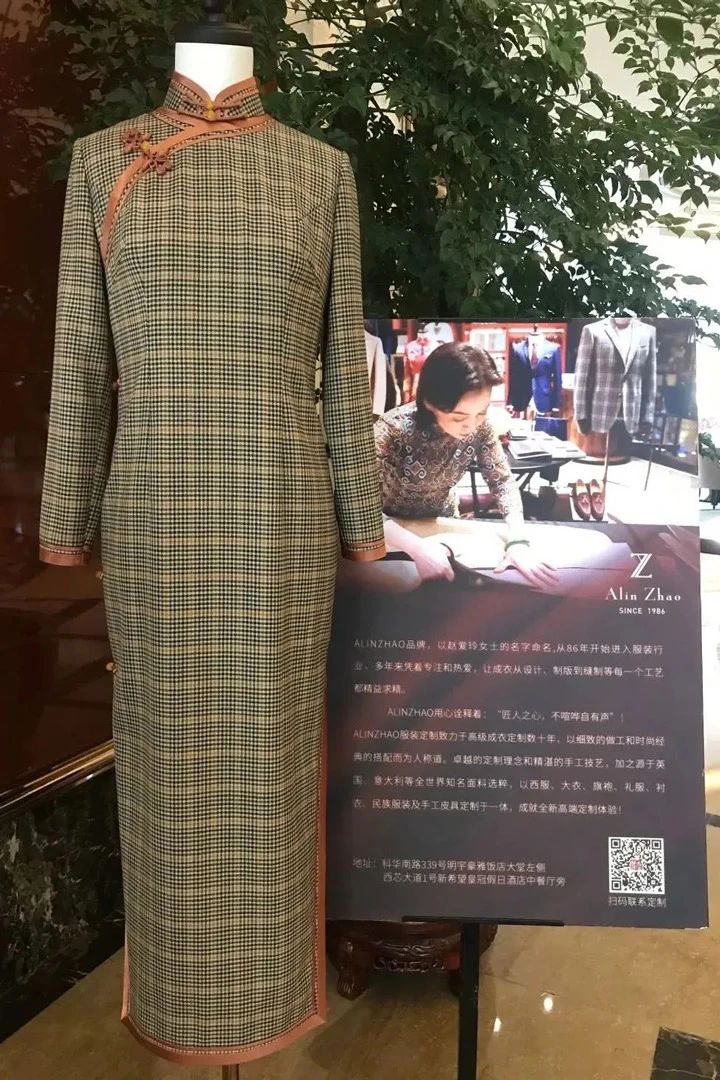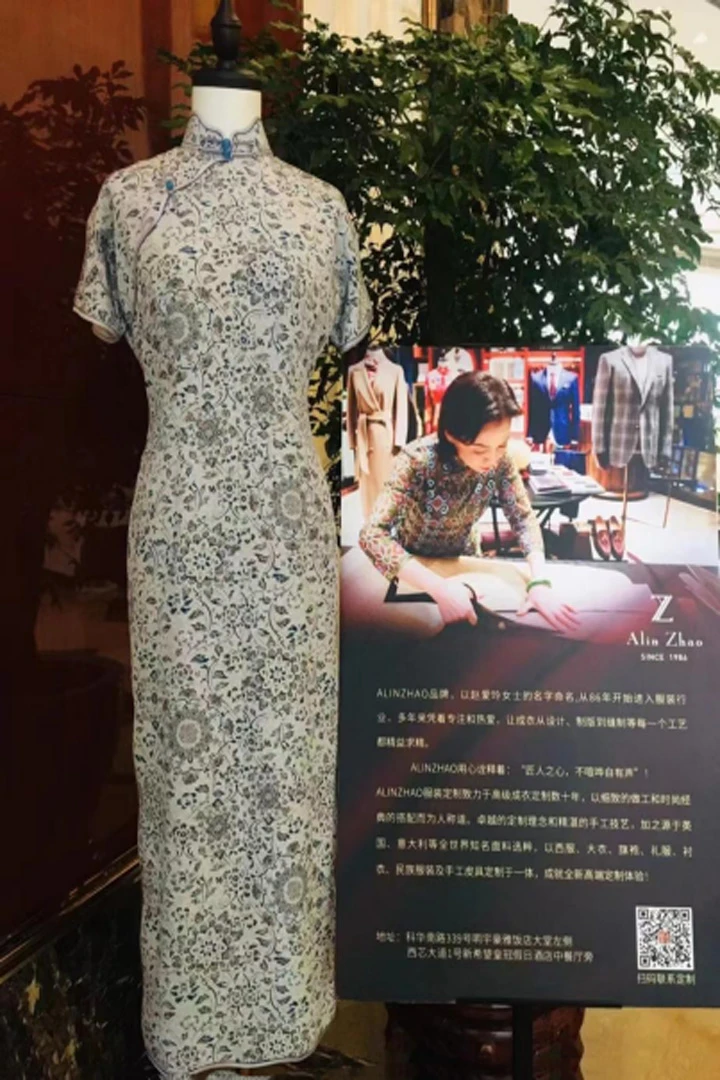The cheongsam, a traditional garment for Chinese women worldwide, is one of the most spectacular phenomena and forms in China’s long-standing clothing culture. Regarded as a “national treasure” and “national dress for women,” the cheongsam has undergone a fascinating evolution, with four distinct schools emerging in the early 20th century: the Shanghai, Beijing, Suzhou, and Cantonese styles. Each school showcases unique characteristics, reflecting the diverse cultural influences and regional aesthetics that have shaped this iconic dress.
The Shanghai-style cheongsam, originating from the glamorous city of Shanghai, rose to prominence in the 1930s and 1940s. Known for its fusion of Chinese and Western tailoring techniques, this style embodies a cosmopolitan spirit and alluring elegance.
The Shanghai cheongsam is characterized by its form-fitting silhouette, which accentuates the feminine curves, and the use of lightweight fabrics such as printed silk, lace, and velvet. The design often incorporates various collar styles, sleeve lengths, and intricate trimmings, showcasing a rich variety of styles. The iconic actress Maggie Cheung’s cheongsam in the film “In the Mood for Love” perfectly exemplifies the Shanghai style’s enchanting beauty.
In contrast, the Beijing-style cheongsam exudes a regal and conservative charm, likely influenced by its roots in the imperial court. This style features a more relaxed fit, emphasizing a stately presence rather than body-hugging curves.
The Beijing cheongsam often employs thicker, traditional silk fabrics like brocade, and is known for its wide borders, elaborate decorations, and the use of gold thread embroidery. The intricate gold-plated buttons, which require a 26-step process to create, add a touch of opulence to the garment. The Beijing style’s adherence to traditional motifs such as peonies, plum blossoms, and celadon patterns sets it apart, lending a mature and dignified allure.
The Suzhou-style cheongsam, born in the picturesque Jiangnan region, embodies a gentle and refined elegance. As the Suzhou embroidery technique flourished, it naturally found its way onto the cheongsam, giving rise to the Suzhou style.
This school is characterized by its use of soft, luxurious silk fabrics like Suzhou silk and Huling satin, and its delicate, intricate embroidery work. The embroidered motifs, ranging from flowers to auspicious symbols, are executed with meticulous precision, resulting in a visually stunning and graceful garment. The Suzhou cheongsam seamlessly blends the beauty of traditional Chinese painting with the art of dressmaking, embodying a poetic and refined aesthetic.
Lastly, the Cantonese-style cheongsam, prevalent in southern coastal provinces, is known for its simplicity and strong Western influence. Often referred to as the “least cheongsam-like cheongsam,” this style is called “changshan” in Hong Kong and Guangdong, due to its resemblance to men’s long gowns. The Cantonese cheongsam is characterized by its streamlined, form-fitting cut, often made from cotton or slightly stiffer fabrics. The silhouette emphasizes an S-shaped figure, with a pointed bust, narrow waist, and tapered hem. The Cantonese style’s minimalist approach and Western-inspired tailoring set it apart from the other schools.
Each of the four cheongsam schools represents a unique facet of Chinese culture and history, capturing the essence of regional aesthetics and the ever-evolving fashion landscape. The Shanghai style, with its blend of East and West, reflects the cosmopolitan spirit of a city that was once the epitome of modernity and glamour. The allure of the Shanghai cheongsam lies in its ability to seamlessly combine traditional Chinese elements with Western-inspired design, creating a garment that is both timeless and fashionable.
The Beijing style, on the other hand, is deeply rooted in the imperial past, exuding an air of regal sophistication and conservative elegance. The use of rich, heavy fabrics and elaborate embellishments speaks to the opulence and grandeur of the imperial court, while the adherence to traditional motifs and patterns reflects a deep respect for cultural heritage.
In contrast, the Suzhou style embodies the gentle, refined beauty of the Jiangnan region, known for its picturesque landscapes, literary traditions, and exquisite craftsmanship. The Suzhou cheongsam, with its delicate embroidery and soft, flowing fabrics, is a testament to the region’s artistic legacy and the skill of its artisans. The incorporation of traditional Chinese painting motifs and techniques elevates the Suzhou cheongsam to a wearable work of art, imbued with a sense of poetry and romance.
Finally, the Cantonese style represents the adaptability and resilience of Chinese fashion in the face of Western influence. The streamlined, form-fitting silhouette and the use of more practical fabrics reflect the pragmatism and modernity of the southern coastal regions, which have long been at the forefront of cultural exchange and economic development.
Today, the boundaries between these four cheongsam schools have become increasingly blurred, as designers and wearers alike draw inspiration from the rich tapestry of Chinese fashion history. Contemporary cheongsams often incorporate elements from different schools, creating a fusion of styles that celebrates the diversity and versatility of this iconic garment.
As we explore the four major schools of cheongsam, we not only encounter the elegance and beauty of this traditional Chinese dress but also gain a deeper understanding of the complex cultural, historical, and regional influences that have shaped its evolution. The cheongsam, in all its variations, remains a powerful symbol of Chinese identity and a testament to the enduring appeal of Chinese fashion on the global stage.
Whether worn as a formal dress for special occasions or adapted for modern, everyday wear, the cheongsam continues to captivate and inspire, transcending time and cultural boundaries. As we appreciate the unique characteristics of each cheongsam school, we also recognize the common thread that unites them all: a celebration of femininity, grace, and the rich cultural heritage of China.
In conclusion, the four major schools of cheongsam – Shanghai, Beijing, Suzhou, and Cantonese – represent a fascinating chapter in the history of Chinese fashion. Each school has its own distinct style, reflecting the diverse regional cultures, aesthetics, and historical influences that have shaped the evolution of this iconic garment.



